 John Morris: His Latest Figments (2)
John Morris: His Latest Figments (2)
Per my previous post in this series, in his increasingly frantic and inept efforts to explain away the glaring discrepancies in the original fiction he spun regarding Robert Capa’s actions on D-Day and the resulting fate of his Omaha Beach negatives, as well as his attempts to elide the improbabilities in the far-fetched “new theory” of those events that he is cobbling together, John Morris, the former LIFE picture editor, keeps digging himself into an ever deeper hole.
The research conducted by myself and others, published in 2014 at this blog, has already forced Morris to change his tune drastically. He now acknowledges that Capa likely made no more than the ten surviving images on Omaha Beach, staying there no longer than the 30 minutes or less that those exposures required, and that therefore no additional negatives of the landing got damaged or lost in LIFE‘s London darkroom on the night of June 7, 1944.
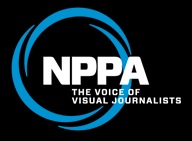 The latest round of these awkward, implausible rationales comes in a document Morris submitted to Bruce Young, a photographer and writer commissioned by the National Press Photographers Association (NPPA) to produce for the organization’s official journal what he describes as “a neutral piece accounting for everyone’s stories and claims.” Morris’s response to questions from Young take the form of a document he issued on January 5, 2015, titled “The A. D. Coleman Attack.” (Click here for a PDF.) Below I continue my list of the untruths therein, each followed by the evidentiary disproofs thereof. — A. D. C.
The latest round of these awkward, implausible rationales comes in a document Morris submitted to Bruce Young, a photographer and writer commissioned by the National Press Photographers Association (NPPA) to produce for the organization’s official journal what he describes as “a neutral piece accounting for everyone’s stories and claims.” Morris’s response to questions from Young take the form of a document he issued on January 5, 2015, titled “The A. D. Coleman Attack.” (Click here for a PDF.) Below I continue my list of the untruths therein, each followed by the evidentiary disproofs thereof. — A. D. C.
•
John Morris Figment 4: “… Coleman however clings to his false belief that the three other beach landing films survive at ICP. He has seen them! — of course confusing them with the pre-invasion films taken by [David] Scherman aboard the USS Chase [sic].” Supporting evidence: None.
Fact: Scherman was never aboard the U.S.S. Chase, and thus made no pictures there. Morris is of course confusing the pictures made by Scherman aboard LST 317 with the pre-invasion images by Capa made aboard the Chase.
I certainly know the difference between Capa’s ten 35mm images of the landing on Omaha Beach — the only exposures he made there, the surviving negatives of which reside in the ICP’s Capa Archive — and Capa’s pre-invasion 35mm exposures, roughly half of the latter preserved in the same repository. I have indeed seen all of those, but I haven’t “confused” them in any way, as my posts on that subject make clear here, here, and here. Morris has deliberately misrepresented my research and my argument.
John Morris Figment 5: “I now regret that I had forgotten and therefore did not make it clear long ago that there had been another June 7 delivery to the London office, containing the pre-invasion Chase films by Scherman (used in LIFE June 19) and Capa’s Chase films (not used as they duplicated Scherman’s).” Supporting evidence: None.
Fact: Morris has told this story hundreds of times since Capa’s book came out in 1947, almost word for word every time (to judge by the dozens of such performances on record in print, audio, and video formats). Yet this newly minted, self-serving addendum appears in none of those accounts.
For example, Morris mentioned no “advance packet” from Scherman including film from Capa when talking to Jozefa Stuart, author of an unpublished biography of Capa, whose research — conducted in the mid- to late 1950s — preceded and underpinned Richard Whelan’s 1985 book. Nor did either Morris or Scherman mention it to Whelan when he interviewed them for that book. Nor did Morris mention it in his own 1998 memoir, Get the Picture! Nor did he mention it to Alex Kershaw when that writer interviewed him for his unauthorized biography of Capa, Blood and Champagne (2003). Nor did he mention it in such recent retelling as the ones in the May 29, 2014 TIME/Magnum/ICP video or Mark Edward Harris’s summer 2014 interview for Black & White magazine.
Suddenly, at the age of 98, Morris recalls such a crucial new incident for the very first time. I find it impossible to take seriously this conveniently recovered memory of the purported “advance packet” containing Capa’s pre-invasion 35mm films that Morris now claims to have received on June 7, 1944, especially given its utter improbability, as explained in the Facts concerning Figment 3 in my previous post. Tellingly, he offers no details, such as when it arrived, who delivered it, what it contained from Scherman, how he felt upon receiving it, who processed it, how he responded to its contents once developed … just the unsupported assertion that it happened.
•
 At his blog Re: PHOTO, the U.K.’s Peter Marshall, who has tracked this investigation from the start, published a response on February 6 to the January 27 post in which I began this deconstruction of Morris’s latest fulminations. In the opening paragraph of that post, “Morris Strikes Back,” Marshall writes, “Reading [Morris’s statement, “The A. D. Coleman Attack”] through I get the feeling of a man who has rather lost touch with reality and is unable to understand much of the research that Coleman and others have put into this and very much wants to make sure the truth remains hidden.” Marshall then sensibly asks,
At his blog Re: PHOTO, the U.K.’s Peter Marshall, who has tracked this investigation from the start, published a response on February 6 to the January 27 post in which I began this deconstruction of Morris’s latest fulminations. In the opening paragraph of that post, “Morris Strikes Back,” Marshall writes, “Reading [Morris’s statement, “The A. D. Coleman Attack”] through I get the feeling of a man who has rather lost touch with reality and is unable to understand much of the research that Coleman and others have put into this and very much wants to make sure the truth remains hidden.” Marshall then sensibly asks,
“[H]ad Capa’s preparations for D-Day rolls arrived along with Scherman’s, who can believe that none of his pictures would have been considered for publication, not even have been edited as Morris suggests. Would any editor presented with pictures by two of his small team of photographers take a look at only one of them, find a few pictures he could use and not even bother to edit those taken by a rather better-known photographer?”
Since, according to Morris today, Capa’s and Scherman’s pre-invasion 35mm films arrived at the same time, well before Capa’s Omaha Beach rolls got there, when the office was merely “packaging the ‘background pictures,’ all of relatively little interest, that now flooded in from official sources,” Morris would have had ample time to assess and edit both sets. Of course, that would have required the darkroom staff to process those films first; yet, according to Morris’s previous story, until Capa’s Omaha Beach films arrived at 9 p.m. on the 7th, “The darkroom staff — all five of them — had been standing by idly since Tuesday morning [June 6].” Morris needs to reconcile the glaring discrepancies here.
Capa’s Chase films, which show troops boarding in Weymouth, studying the scale model of the coastline in the gym of the Chase, and other events aboard a massive warship, could hardly have “duplicated Scherman’s.” The latter sailed on a small Landing Ship, Tank (LST) outfitted as a hospital ship, with 5 Jeep-Ambulances and a capacity of 150 troops, all of them medics. By contrast, the Chase, an Attack Transport (APA-26), fully armed, with a crew of almost 500, transported 33 Higgins boats as landing craft for the 1500 combat troops and officers it carried. Few of Capa’s pre-invasion 35mm exposures look like Scherman’s (those published in LIFE, in any case); many are strikingly different.
On the Origin of the Specious
This “advance packet” factoid made its official debut in Whelan’s text for the 2007 exhibition catalogue This Is War! Robert Capa at Work, in which, typically, the Capa estate’s hireling provides no source or evidence for it, nor (as with Morris) any details. Since Whelan never met Robert Capa, who never mentioned this “advance packet” in anything he wrote, and Morris claims that he has just now recalled it and has never spoken of it previously, Whelan couldn’t have heard it from Morris. In short, Whelan simply made it up, as I have argued at length.
Whelan, a devoted servant of the Capa estate, repeatedly falsified the record when his employer required it, chose not to footnote his researches thoroughly, and apparently took his documentation to the grave with him. His credibility on this score is nil.
Like Whelan before him, Morris now needs to explain the inarguable presence in the ICP’s Capa Archive of an additional four rolls of captioned 35mm film from Capa’s D-Day output (plus caption notes for a fifth such roll), film that the former LIFE picture editor neglected to mention for 70 years. This “advance packet” fantasy represents nothing more than Morris trying to catch and run with Whelan’s Hail Mary pass.
So Morris now has an obligation to square it with such previous narratives as this, from his 1998 memoir Get the Picture:
“All day Tuesday we waited, and no pictures. … We were now waiting in the gloom of Wednesday, June 7, keeping busy by packaging the “background pictures,” all of relatively little interest, that now flooded in from official sources. [That can’t possibly describe either Scherman’s images of the crossing or Capa’s.] The darkroom staff — all five of them — had been standing by idly since Tuesday morning, their anxiety about the pressure they would be under growing steadily by the hour. This nervousness would soon result in an epic blunder [the fictional ’emulsion melt’].
“At about 6:30 Wednesday evening, the call came in from a Channel port: Capa’s film was on the way. “You should get it in an hour or two,” a voice crackled over the line before fading into static. … Around nine, a panting messenger arrived with Capa’s little package: four rolls of 35-millimeter film plus half a dozen rolls of 120 film (2 1/4 by 2 1/4 inches) that he had taken in England and on the Channel crossing.”
And this, from the June 5, 2004 New York Times:
“Back in London we waited. No word from our photographers all day Tuesday. … All day Wednesday we waited, until finally about 6 in the evening I got a call saying that Capa’s film was on the way to London from ‘a channel port’ by courier.”
•
Chalking it all up to the fog of war photography simply won’t do. In Morris’s recently recuperated memory of that “advance packet,” it contained all of Scherman’s films from his own crossing and return aboard Navy LST 317, plus Capa’s pre-invasion 35mm negatives with handwritten captions. According to Morris, Capa had miraculously managed to get some of his pre-invasion films (but, inexplicably, not his films in 120 and 4×5 formats) transferred from the U.S.S. Samuel Chase to Scherman’s LST 317 sometime during the night of June 5 — despite the stormy seas, the visual blackout of the entire invading 5000-ship armada, and the radio silence in which they traveled.
None of that makes sense. Combat photographers don’t hand off their exposed films for safekeeping or transportation to other combat photographers going into battle along with them, and thus no less at risk. Capa, a consummate professional, most likely kept all his exposed films on his person or in his pack.
It remains unclear on which vessel Scherman made his return trip from the Normandy coast, as does the exact time he landed back in England and the means by which he got his films of the crossing to London. The answers may lie in the interview with him conducted by Whelan, presently missing and presumed lost.
Capa certainly sent Morris his own films as soon as possible upon landing in England. Scherman of course did the same. (So far as I can determine, Morris has never previously referred specifically to his receipt of Scherman’s films, their processing, or his editing thereof.) We know that Capa and Scherman encountered each other in Weymouth on the morning of June 7, where Scherman made a famous portrait of Capa. In the only authoritative first-hand account we have of that meeting, Scherman’s, as published in LIFE in its June 26, 1944 issue (p. 19), Capa met his colleague’s boat by accident, expecting instead to photograph the wounded being taken ashore.
This suggests that Capa had decided to complete his coverage of the invasion by making it a round-trip account, bookended by images of the troops boarding their ships on June 4 and pictures of their injured counterparts disembarking on June 7. He would have done so just before shipping his films to London. Applying Occam’s razor to this situation, logic proposes that, upon bumping into each other thus, Capa and Scherman combined all their films into one package, found the first available courier, and sent their entire coverages of the invasion to Morris in London, where it arrived inexplicably late at LIFE‘s office on the night of June 7.
John Morris Figment 6: “Cynthia Young, although having no proof, guessed that there had been a first packet, and Marie Brenner of Vanity Fair also got it right.” Here Morris refers yet again to what he calls the “advance packet” he has just now for the very first time recalled receiving from David Scherman sometime on June 7, 1944, supposedly hours before the arrival of Capa’s Omaha Beach negatives, contrary to the accounts immediately above. Supporting evidence: None.
Facts: (a) Cynthia Young (no relation to Bruce Young, so far as I know), who worked with Richard Whelan on the 2007 exhibition and catalogue This Is War! Robert Capa at Work, and took Whelan’s place as the curator of the ICP Capa Archive after his death that same year, didn’t “guess that there had been a first packet” — she simply inherited this confabulation from her compromised and corrupted predecessor. Of course she had no proof; none exists, or could exist, because this never took place.
(b) Marie Brenner does not “get it right.” Like Morris, she fails to mention any “advance packet” containing films by Capa and Scherman in her June 2014 Vanity Fair puff piece. Here’s what she writes:
“On June 5, 1944, Capa roamed the transfer ship U.S.S. Henrico with his Contax, aware that the London bureau of Life was already frantically waiting for his film. [‘Frantically waiting’ for exposures he would not make until the next morning, which they could not reasonably expect to receive for at least 24 hours?] …
“At Weymouth [on June 7], Capa positioned himself so he would be ready to photograph the medics coming for the wounded. Instead, when the bow doors opened, there was another Life photographer, David Scherman, waiting to capture the faces of the injured. Scherman hugged him and took the picture of Capa with his cigarette in his hand, his helmet at a jaunty angle, and a triumphant smile on his face. Capa scribbled a note to Morris telling him that the action was all on the 35-mm. rolls, then got on board the next transport back to Normandy. Capa, who prided himself on not knowing what he shot, knew exactly what he had that day: four rolls full of what could well be the most stirring images of warfare ever created. …
“‘All that day, I waited and waited. I heard nothing. Everyone in the darkroom was poised. All that night, I did not sleep, waiting for Capa and his film’ [says Morris]. At 6:30 on Wednesday night, June 7, a call finally came from the Channel: ‘You should get it in an hour or two,’ then static destroyed the line. Around nine P.M. a small package was finally delivered; it contained the four rolls of 35-mm. film and six rolls of 120 film that Capa had shot in England, on the Channel crossing, and at Omaha [sic].”
•
I’ll conclude this analyis in my next post.
•
(For an index of links to all posts in this series, click here.)


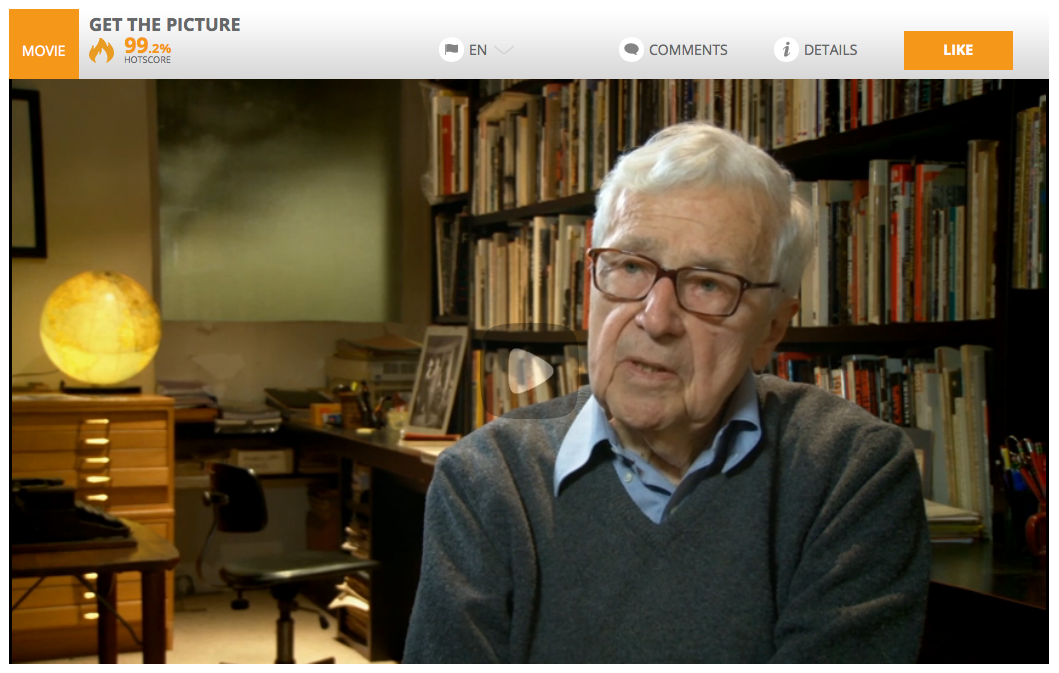
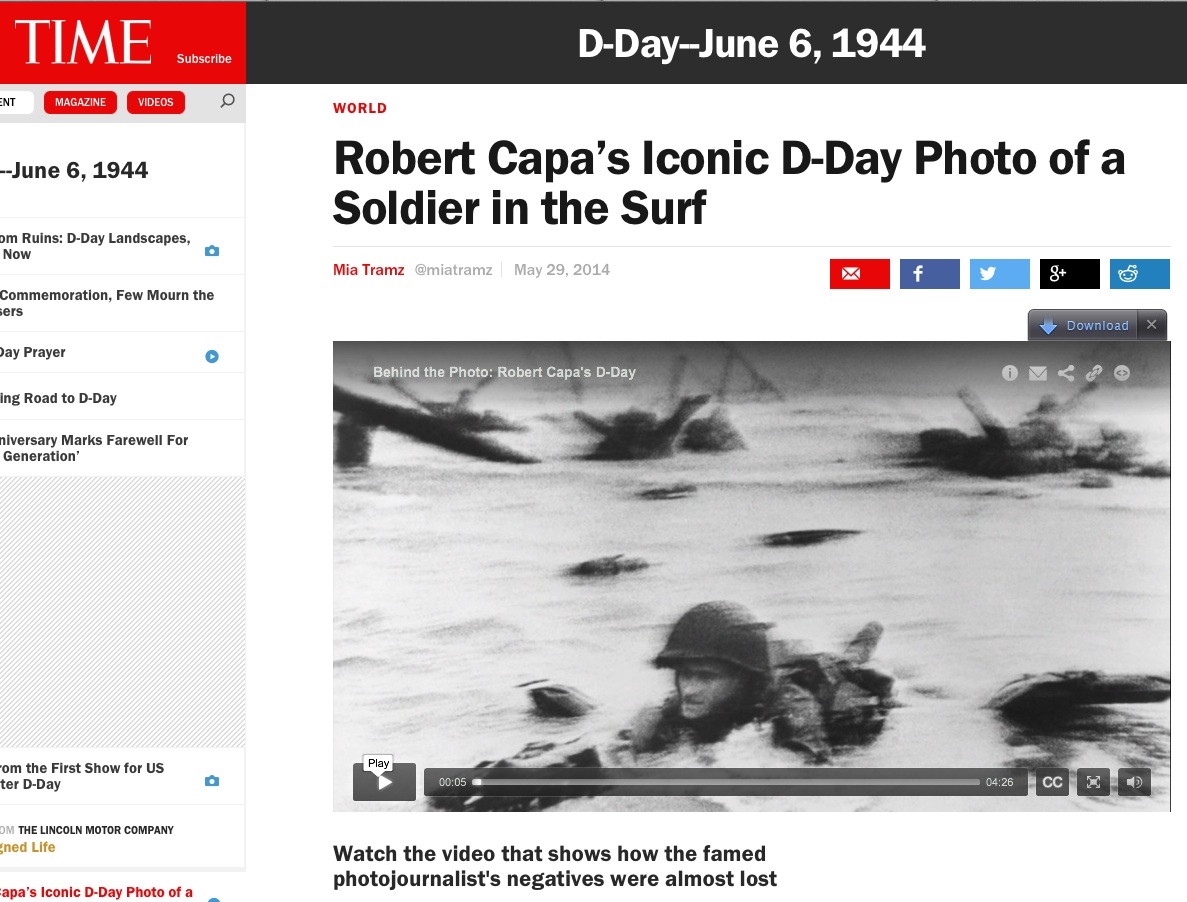
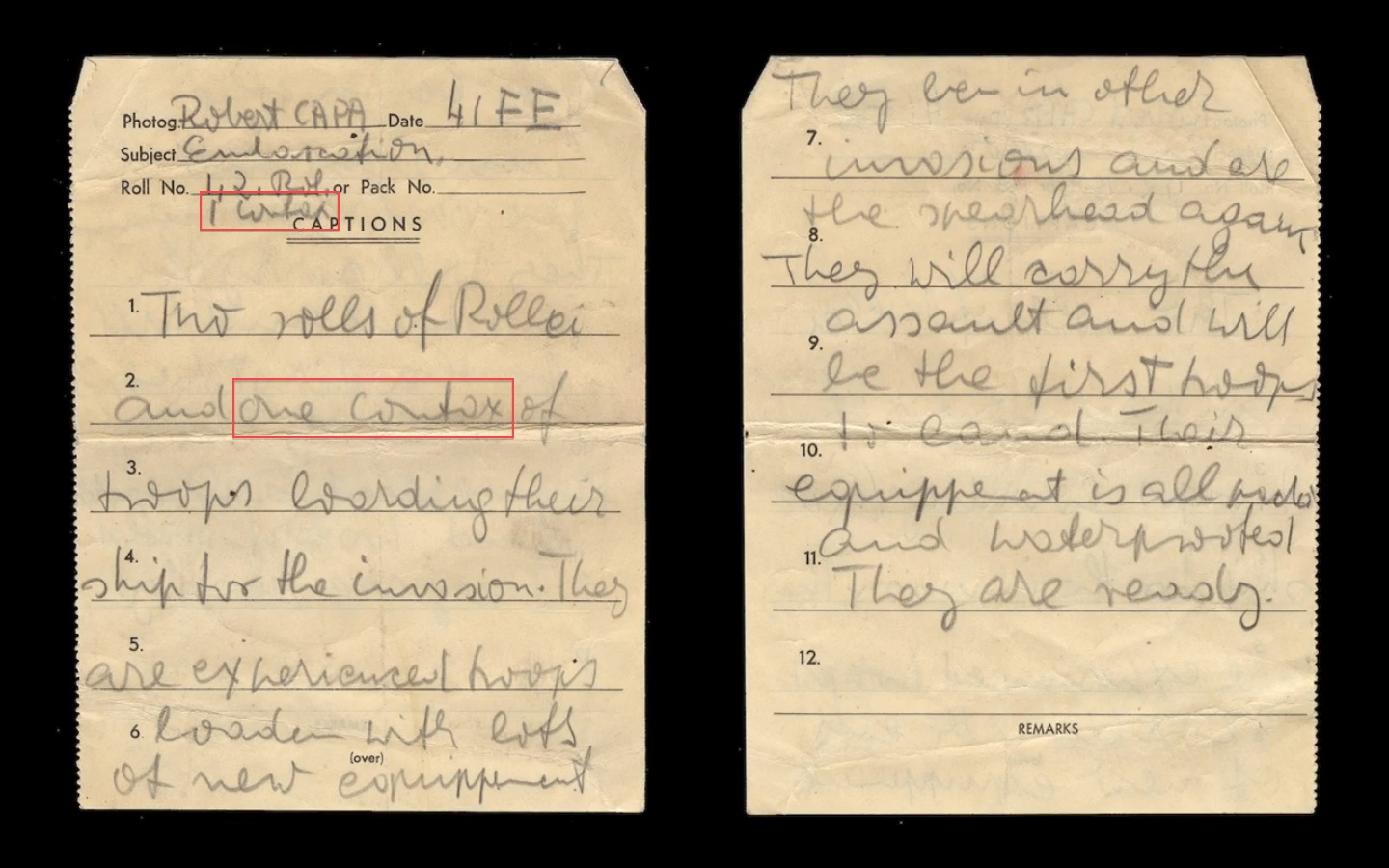
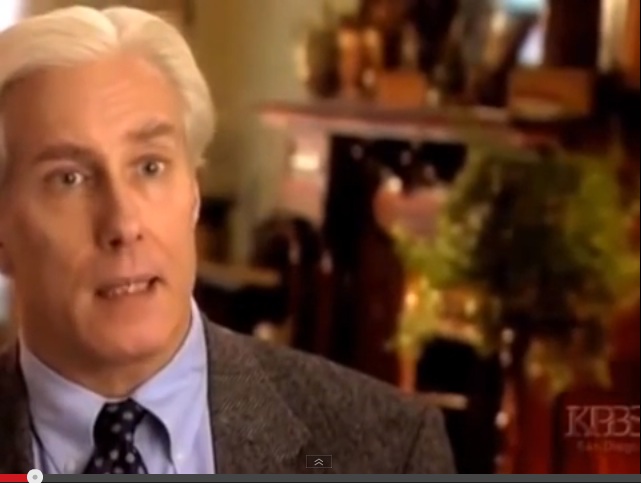
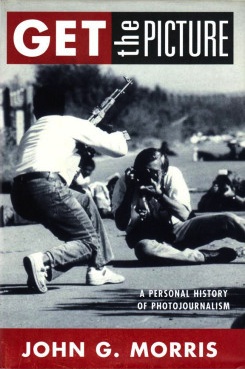
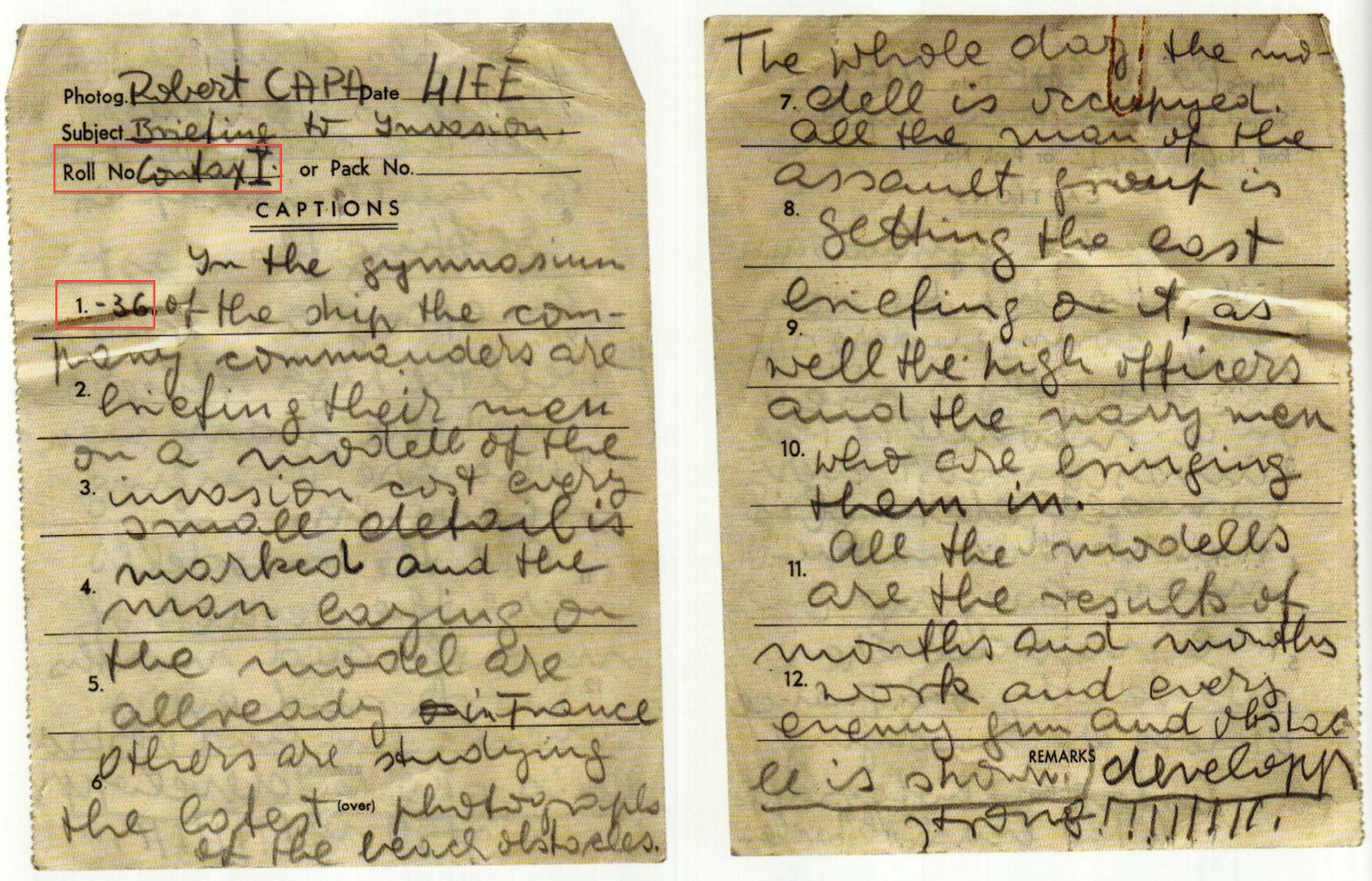
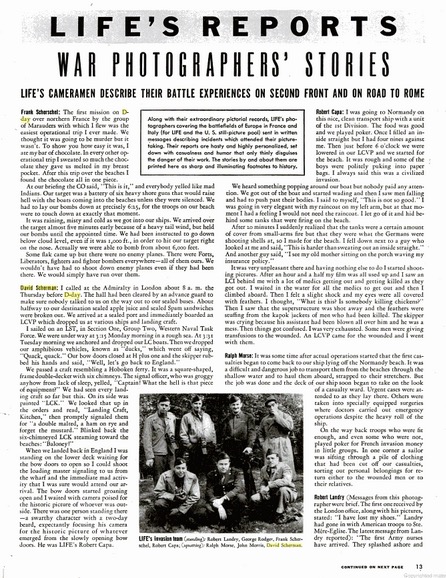
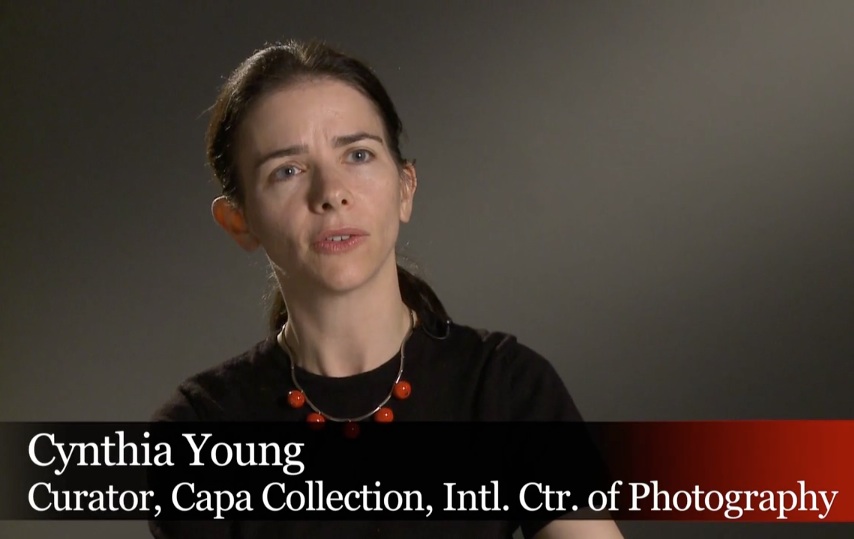
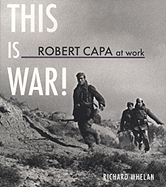
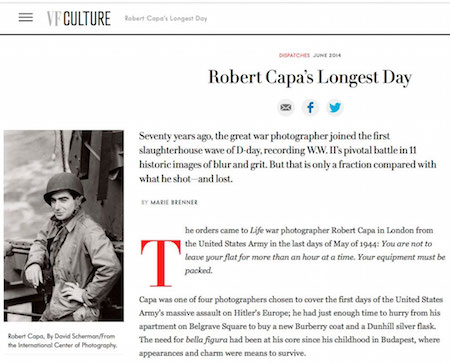




Leave a Comment